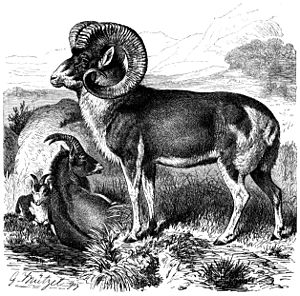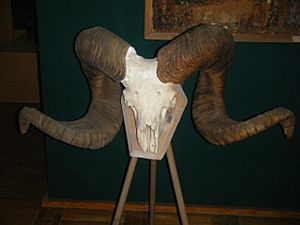Marco Polo sheep facts for kids
The Marco Polo sheep (Ovis ammon polii) is a type of wild sheep. It is a subspecies of the Argali, which is the largest wild sheep in the world.
This sheep gets its name from the famous explorer Marco Polo. He wrote about these sheep during his journey across the Pamir Mountains in 1271. Marco Polo sheep are especially known for their incredibly long horns. The longest horn ever found on a sheep belonged to a Marco Polo sheep and measured 191 centimeters (75 inches)! This sheep is unofficially considered the national animal of Afghanistan.
Contents
Amazing Features of Marco Polo Sheep
These sheep are famous for their long, spiraling horns. These horns can spread up to 140 centimeters (55 inches) wide. They have the longest horns of all sheep species. The longest single horn ever recorded was about 1.9 meters (6.2 feet) long and weighed 27 kilograms (60 pounds). The horns of O. a. polii curl in a special way, with the tips pointing straight out from the head. Even with their long tips, the horns rarely break.
Hunters have long found these horns very appealing as trophies. The horns start growing when the lambs are 15–20 days old. They grow fastest in length during the first year. The horns get thicker mostly during the first two years of the sheep's life.
Marco Polo sheep have dark brown fur with white fur on their undersides. A dark band of hair separates these two colors. They also have a white patch on their rump, which is clearer on O. a. polii than on other argali subspecies. As winter comes, the white hair on male sheep grows longer, forming a noticeable ruff around their neck. However, this ruff is less prominent on Marco Polo sheep compared to other argali. Female sheep have lighter coats than males, and their fur does not change as much with the seasons. The face of a Marco Polo sheep is lighter in color than its body.
Most argali sheep have a round tail that is about 6 to 10 centimeters (2.4 to 3.9 inches) long, ending in a tuft of hair. The tail of a Marco Polo sheep is a bit longer, usually around 12 to 16 centimeters (4.7 to 6.3 inches).
Life Cycle and Size
Adult male sheep, called rams, weigh about 126 kilograms (278 pounds) on average. At the withers (the highest part of the back at the shoulder), rams grow to about 113 centimeters (44 inches) tall. Female sheep, called ewes, are about 100 centimeters (39 inches) tall.
The sheep mate in December. Pregnancy, called gestation, lasts about 160 days. Usually, a single lamb is born, and twins are not common. One ewe in captivity once gave birth to five lambs at once, and then triplets two years later!
Marco Polo sheep typically live for about 13 years. Male sheep's horns develop rings each year. These rings can be used to figure out how old the male sheep are. Since females do not have horns, it is harder to know their exact age.
Scientists do not have much information about how easily these sheep get sick. However, tests on similar sheep species suggest they might be quite strong. Marco Polo sheep usually stay away from people. This means they are unlikely to catch diseases common to farm animals. Some farm sheep do roam freely in the mountains. It is not known if they come into contact with Marco Polo sheep. Local shepherds often do not have access to vet care for their animals. It is possible that their animals could pass diseases to the wild sheep.
Where Do Marco Polo Sheep Live?
Most Marco Polo sheep live in the Pamir Mountains. This region is near the borders of Afghanistan, Pakistan, Kyrgyzstan, Tajikistan, and China. They live at very high elevations, from 3,700 to 4,800 meters (12,100 to 15,700 feet) above sea level.
This subspecies mainly lives in the northwestern part of the Hunza district in Pakistan, along the Chinese border. They can be found in the Kilik Mintaka border area and the northwestern part of Khunjerab National Park. Marco Polo sheep also live in the Wakhan Corridor along the Afghanistan border. They share their home with other animals, such as the Siberian ibex. During summer, Marco Polo sheep prefer areas near rivers and lots of plants. In winter, they like gentler, south-facing mountain slopes.
How Do Marco Polo Sheep Behave?
Marco Polo sheep act much like other members of the Ovis genus (the group that includes all sheep). They usually live in small groups of a few dozen sheep. In the summer, they split into even smaller groups, with males and females staying separate. However, during and after the mating season, they gather into larger groups. This helps them protect themselves and save energy.
When the mating season begins, male rams start fighting to become the leader of their flock. The strongest rams then get to choose their ewes without competition from the losers. Only mature rams, usually those over 6 years old, fight for dominance. Younger males might sometimes challenge older ones, but they never actually charge them.
Mature rams fight by standing next to each other and spinning around. Then, one steps back and charges forward. Marco Polo sheep males have been seen rising up on their hind legs when they clash with opponents. This is not common in sheep that live in lower areas, but it is similar to how goats fight. The males often make grunting sounds while fighting. They also commonly chip their horns or break their noses during these battles.
Once the leader has been decided, the rams start choosing their ewes. Marco Polo sheep rams are known to gather females together. However, during the mating season, males will pair off with specific females to reproduce.
Other pages
Images for kids
See also
 In Spanish: Carnero de Marco Polo para niños
In Spanish: Carnero de Marco Polo para niños




